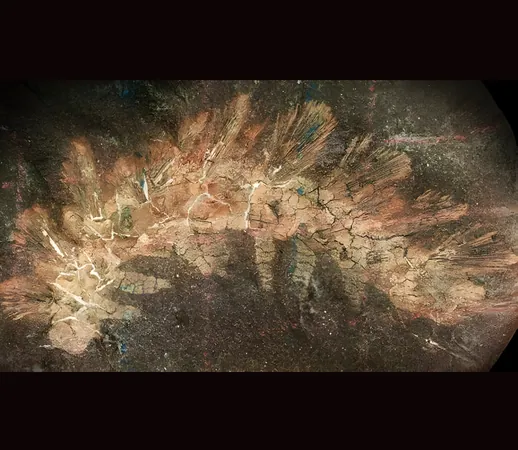
Ancient Fossil Uncovers New Insights Into Evolution: Sea Creatures Dared to Walk on Land!
2025-07-26
Author: Noah
A remarkable fossil, unearthed during the Civil War, has defied over a century of false labeling. Initially dismissed as a humble seaworm, scientists have now unveiled its true significance.
Meet the Game-Changer: Palaeocampa anthrax
Enter Palaeocampa anthrax, a creature that researchers at the University of Michigan believe to be the first of its kind to make the transition from ocean depths to terrestrial landscapes.
The Discovery That Shook the Scientific Community
Stored away in a drawer at Harvard's Museum of Comparative Zoology, the fossil caught the eye of Richard J. Knecht, a postdoctoral researcher. Intrigued by its mismatched label, Knecht closely examined the specimen and quickly realized something extraordinary: it wasn't a millipede, caterpillar, or worm—it was a lobopod.
Unraveling the Mysteries of Lobopods
These ancient, soft-bodied invertebrates, resembling legged worms, are the ancestors of arthropods—think insects, spiders, and crustaceans. Up until this groundbreaking finding, lobopods were believed to have exclusively inhabited marine environments over 500 million years ago.
"This is the first evidence that we have that this group actually did leave the ocean," Knecht exclaimed, noting the monumental evolutionary leap inherent in transitioning from saltwater to land.
Centuries of Mistaken Identity
Since its discovery, the lobopod fossil has been repeatedly misclassified. Even photographs have appeared in scientific literature without anyone grasping its true identity. Knecht remarked, "When the specimen was first discovered, lobopods didn’t even exist as a group. This highlights the value of revisiting older specimens for fresh insights."
A Closer Look Behind the Spines
At first glance, the lobopod appears akin to a furry caterpillar, adorned with tiny spines. However, further inspection revealed its uniqueness. Unlike other lobopods, whose spines form stacked cone patterns, Palaeocampa anthrax's segmented spines resemble bamboo and feature flat, turret-like tips. Even more intriguingly, orange halos encircling the tips prompted researchers to wonder if the fossil held chemical secrets.
The Chemical Clue to Survival
Partnering with physicist Nanfang Yu from Columbia University, Knecht employed infrared spectroscopy to uncover fossilized molecules at the spine tips. This suggested a potential form of chemical defense that would suit a terrestrial environment much better than an aquatic one.
A Rarity in Fossil Finds
Finding such a well-preserved soft-bodied fossil is exceedingly rare. Invertebrates lack bones, leading to swift decomposition. The preservation of Palaeocampa anthrax hinged on it being buried in the right conditions—specifically in oxygen-poor waters rich in fine sediments.
Mazon Creek in Illinois and Montceau-les-Mines in France, known as Lagerstätten, are esteemed for their extraordinary fossil preservation. This lobopod is not only one of only two from the Carboniferous period, it is the youngest example ever discovered, potentially the first to exhibit signs of life venturing from the sea.
Why This Discovery Matters
This fossil does far more than rectify a case of mistaken identity. It suggests that lobopods might have embarked on their terrestrial journey much earlier than previously believed.
Ultimately, it underscores the importance of examining old specimens through modern lenses. A long-neglected fossil has rejuvenated a chapter of Earth's evolutionary narrative, making waves in the scientific community.
The full study detailing these findings has been published in the journal Communications Biology.









 Brasil (PT)
Brasil (PT)
 Canada (EN)
Canada (EN)
 Chile (ES)
Chile (ES)
 Česko (CS)
Česko (CS)
 대한민국 (KO)
대한민국 (KO)
 España (ES)
España (ES)
 France (FR)
France (FR)
 Hong Kong (EN)
Hong Kong (EN)
 Italia (IT)
Italia (IT)
 日本 (JA)
日本 (JA)
 Magyarország (HU)
Magyarország (HU)
 Norge (NO)
Norge (NO)
 Polska (PL)
Polska (PL)
 Schweiz (DE)
Schweiz (DE)
 Singapore (EN)
Singapore (EN)
 Sverige (SV)
Sverige (SV)
 Suomi (FI)
Suomi (FI)
 Türkiye (TR)
Türkiye (TR)
 الإمارات العربية المتحدة (AR)
الإمارات العربية المتحدة (AR)